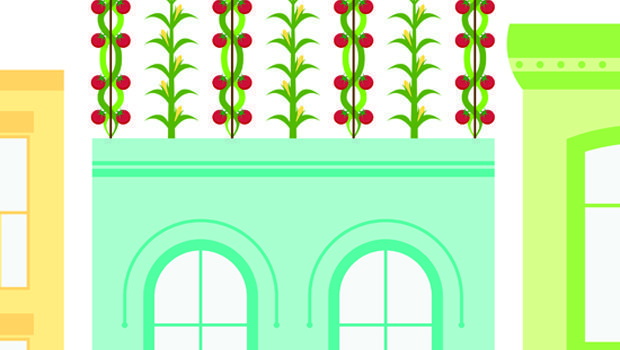Urban Gardening Takes Root
Feeding Ourselves Well
In just one-twelfth of an acre, including lots of paths and a compost heap, our family grows the vast majority of the fresh vegetables we need, plus a decent chunk of our fruits and berries,” says Erica Strauss. “It’s not a huge garden, but we still feel nearly overwhelmed with the harvest in late August.” Her family of four tends a diversity of edibles on their urban lot in a suburb of Seattle, Washington.
Word has spread because Strauss writes about her experiences via Northwest Edible Life, a blog about food growing, cooking and urban homesteading. “Every kid on the block has picked an Asian pear off my espalier and munched on raw green beans,” she notes. “Even picky eaters seem pretty interested when they can pick tasty treats right from the tree or vine.”
We don’t need to live in a rural area or on a farm to grow our own food. By the close of World War II, nearly 40 percent of all fruits and vegetables supplying Americans stateside were grown in victory gardens in the communities in which they were consumed.
Today, these small plots are often termed kitchen gardens, comprising parts of household lawns, schoolyards, balconies, patios and rooftops. Fresh taste and the security of local food supplies in case of manmade or natural upheavals are drawing more people to gardening.
Garden Cities
“Urbanization, a major demographic trend, has implications for how we grow and consume food,” observes Roger Doiron, founder of Kitchen Gardeners International. “If we agree that feeding more people fresh, local foods is a priority, we’re going to need to landscape and, in many cases, retrofit urban and suburban areas for increased food production.”
Millions of Americans now participate in growing mainstay foods.
According to a 2009 study by the National Gardening Association, 31 percent of all U.S. households grew food for their families in 2008, and more have since the economic downturn. Bruce Butterfield, the association’s research director, estimates that nearly 70 percent of these gardens are in urban or suburban areas.
“We’re seeing a new crop of farmers that defy stereotypes,” observes David Tracey, owner of EcoUrbanist environmental design in Vancouver, Canada, and author of Urban Agriculture. “Some are office workers leaving unsatisfying jobs, techie types learning the trade in universities and back-to-the-land folks that happen to live in cities. Others are activists taking on the industrial farm system, folks adopting trends or entrepreneurs that see opportunities in the rising prices of quality food and the proximity of millions of customers.”
Opportunities and Pitfalls
Urban gardening has unexpected advantages in its use of organic waste like coffee grounds from a local coffee house and rainwater from area rooftops. Converting lawns at schools, churches and empty city lots into community gardens fosters community connections, improves access to affordable nutritious foods and creates employment opportunities.
A widespread challenge to the trend is dealing with the quality of urban soil and testing for possible toxins. Often, urban soil must be improved using compost and other nutrients before plants can prosper. A nearby irrigation source is also required.
“One potential problem for urban gardeners may be the community reaction to an edible landscape,” admits Strauss. “In some cities, edible gardens in the front yard or even the common parking strip are celebrated and even officially encouraged. But in communities where lawn is still king and city codes regarding vegetation are vague and open to interpretation, one complaint from an anonymous neighbor can become an exhausting political and legal fight.”
Feeding Community
Community gardens often transform vacant lots and other marginal land into green growing places. In Chicago, The Peterson Garden Project, an award-winning nonprofit program, has been turning unsightly empty lots into raised-beds in which residents learn to grow their own food since 2010.
“Nationally, it’s been found that having a community garden on unused land increases property values, decreases crime and promotes a sense of unity with neighbors and others,” explains LaManda Joy, president and founder of the project. “We work with property owners on the short-term use of their land to enhance the community in which they eventually plan to develop.”
“Participating in a community garden serves up a lot of individual victories,” says Joy. “Improved health and nutrition, learning a new skill, teaching kids where food comes from, productive exercise, mental well-being, connecting with others and saving money—community gardens help make all of this possible.”
Being Prepared
“How many recalls have we seen because some food item has been contaminated and people have suffered or died as a result? I am concerned about the safety and security of our food supply,” says Wendy Brown, whose family tends a quarter-acre garden with raised and landscaped beds and containers wrapped around their home plus an onsite greenhouse in a beach resort suburb of Portland, Maine. “As a mother, it concerns me that I might feed my children something that will hurt them. High-fructose corn syrup, genetically engineered crops and BPA-lined cans are all making headlines. It just seems smarter to grow it myself; that way, we have more control over what our family is eating.”
Brown is one of more than 3 million Americans that are following FEMA recommendations in preparing for any event that might disrupt food supplies. Her book, Surviving the Apocalypse in the Suburbs, shares everything her family has done to safeguard themselves, including growing produce, caring for animals and canning, freezing, drying, cold storage or fermenting foods for later use.
“For me, it’s more about being prepared for the everyday things that are happening, like increases in food and fuel prices or a loss of family income,” Brown says. “If we’re growing at least some of our own food, I have a lot less to worry about when such things happen.”
The family also keeps rabbits and ducks, plus egg-laying and meat-providing chickens that can total 40 animals in the summer at their “nanofarm”. These also supply natural fertilizer for the crops. Nearby beehives provide 20 pounds of honey each year. Because the foods they produce are solely for their personal use, the Browns are exempt from regulatory restrictions.
“Our neighbors love what we’re doing,” says Brown, whose house is close enough they can chat across their front porches. “One says our initiative reminds him of growing up in Maine pretty much self-sufficient. The other tells friends and coworkers they aren’t worried if things really go bad because they have us as neighbors.”
Helpful Resources
Green Restaurant Association, DineGreen.com
Kitchen Gardeners International, KGI.org
Northwest Edible Life, NWEdible.com
The Peterson Garden Project, PetersonGarden.org
Uncommon Ground, UncommonGround.com
Urban Farm Online, UrbanFarmOnline.com
Urban Garden Magazine, UrbanGardenMagazine.com
Urban Gardens, UrbanGardensWeb.com
Growing Green Thumbs
“With some effort, urban gardeners can grow great vegetables anyplace that affords enough light and warmth,” advises Strauss, who gardens primarily in raised beds in her front and back yards. “I garden on the scale I do because I love it. It’s both relaxing and challenging, and we eat well.”
Urban gardening methods are as diverse as the growing conditions, space limitations and financial resources of the gardener.
“Lasagna” gardening—layering newspaper or cardboard and other organic materials on top—can be effective in urban areas because it involves no digging or tilling. Just as with making compost, alternate between brown and green layers. Once the materials break down, add plants to the newly created growing bed.
Urban dwellers with limited space may employ square-foot gardening, intensively growing plants in raised beds using a growing medium of vermiculite, peat moss and compost. This method can yield fewer weeds and is easier on the back. “It’s an easy concept to grasp for new gardeners,” remarks Joy. “We use it to both maximize output in a small area and ensure healthy, organic, contaminant-free soil.”
Rooftop gardens are becoming more common as larger agricultural operations use them to grow income crops. The U.S. Department of Agriculture considers anyone that sells more than $1,000 of produce to neighbors or area restaurants a farmer, rather than a gardener, so regulations may apply.
For renters, just a few tomato plants in a well-maintained container on a patio or deck can yield as much as 50 pounds of tomatoes by taking advantage of its microclimate, influenced by wind blocks, heated surfaces and reflected light from windows.
Urban gardening is also thriving indoors in terrariums, window boxes and small greenhouses. Even partially lit rooms can support certain vegetables or herbs with grow lights. Aquaponic gardening, a closed-loop system that involves both fish and vegetables, expands the self-sufficient possibilities of a hydroponic system of growing plants fed by liquid nutrients.
Feeding Ourselves
With more than 80 percent of Americans currently living in urban and suburban areas, the questionable nutrition of many mass-produced foods, increasing pesticide and herbicide use by non-organic farmers, greenhouse gas emissions from food transport and weather patterns altered by climate change, it’s past time to take back some control. Operating our own gardens and preparing our own meals turns us back into producers, not merely consumers.
“For the most part, we’re just average suburbanites,” concludes Brown. “We just choose to have less lawn and more garden. A huge benefit is that we need less income because we’re buying less at the grocery store. Our goal is to semi-retire in our mid-50s—not because we’ve made a bunch of money, but because we’ve needed less money to live along the way.”
Local Foods Grow on Menus
“Many restaurants are seeking to lower ‘food miles’ and offer fresher, more local food,” reports Michael Oshman, founder and CEO of the Green Restaurant Association, which certifies sustainably operated restaurants. The 500-plus restaurants certified since 1990 include university, government and corporate cafeterias.
The award-winning Uncommon Ground restaurant, in Chicago’s Edgewater neighborhood, maximizes the nation’s first certified organic rooftop farm using just 654 square feet of soil. Combined with its Wrigleyville restaurant’s “sidewalk farm”, client chefs receive 1,200 pounds of fresh produce each year, valued at more than $5,600. Ingredients not grown onsite are sourced directly from regional farms, with their names often appearing on the menu. Community education is also part of the program.
According to the “What’s Hot” National Restaurant Association nationwide survey of chefs, hyperlocal food sourcing, including rooftop farms, was the fifth-most-popular trend in 2011. Also in the top 10 were locally grown produce sourced from area farmers, farm-branded ingredients and sustainability.
“Customers now have an opportunity to demand local and organic ingredients as much as possible,” concludes Oshman. More Americans than ever want to know the origin of what’s on their plate.




























